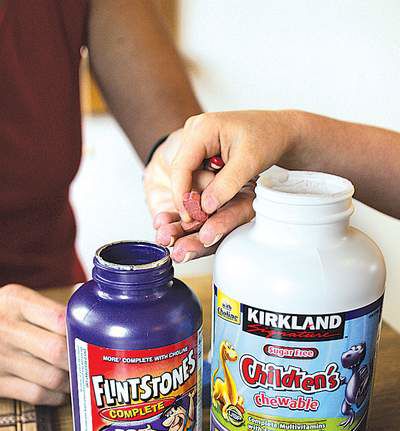Kids’ vitamins
Published 5:00 am Thursday, August 11, 2011

- Kids' vitamins
Aleta Nissen, like many parents, wonders what’s in the best interest of her child when it comes to vitamins. Does her 5-year-old daughter need a supplement? Which kind is best? The amount of sugar in the children’s vitamins bothers her. But artificial sweeteners in kids’ vitamins troubles her even more.
“My main goal is to look for a vitamin that is not mainly sugar, and it’s pretty tough,” she said. “What Annika begs for in a vitamin when we’re shopping is anything gummy. I guess because they’re so much like candy.”
Trending
The sugar question
There’s a reason for that.
Children don’t typically swallow pills, and getting them to chew something bitter is unlikely, said Mia Neeb, a registered dietitian who specializes in pediatrics, and Michelle Brandt, a pediatric pharmacist, both from St. Charles Bend.
Neeb said there’s about a half-gram of sugar in one serving of most chewable vitamins, while gummy bear vitamins have closer to 4 grams of sugar per serving. In that sense, chewables may be a better choice, Neeb said. Plus, Brandt added, chewable vitamins tend to contain more minerals.
Neeb said in either case, it’s a pretty small amount of sugar: 4 grams equals about 1 teaspoon of table sugar, she said. If tooth decay is the concern, Brandt suggested chewing vitamins in the morning before brushing teeth.
Different supplements have different kinds of sugar, but the body will metabolize fructose versus sucrose the same, Neeb said, so she doesn’t recommend any one form of sugar over another. As for artificial sweeteners, the U.S. Food and Drug Administration has approved aspartame, sorbital or sucralose in those amounts as safe for kids, Neeb said. “It’s the parent’s choice,” she said.
Trending
Some artificial sweeteners have been known to give some people headaches. Some have been linked to a higher rate of cancer in lab rats.
Nutritional needs
Parents who are quite concerned about sugar might not have to supplement with a vitamin anyway. By all accounts, vitamins and minerals are better absorbed through food than supplements. Generally, healthy kids could get all their nutritional needs through a well-balanced diet, with the possible exception of vitamin D in the winter, Neeb and Brandt said.
However, both experts, who are also moms, understand that kids can be picky and might reject entire food groups for phases of time.
So parents should determine where their children’s diets are deficient, and look for supplements that contain those vitamins. Someone who consumes no animal products might need B12, iron and calcium supplements, for example.
“They might not get a complete and balanced diet no matter how hard you try. In that case, a multivitamin won’t hurt,” Neeb said. “However, there’s no universal recommendation that children need a supplement.”
Absorbing nutrients from food
Joshua Phillips, a naturopath who practices family and pediatric medicine at the Hawthorn Healing Arts Center in Bend, said how well a child absorbs his nutrients from food depends on how healthy his digestive system is. Phillips recommends probiotics to create a healthy microbial situation in the gut that will best absorb nutrition from food. Food sensitivities to things like wheat (gluten) or dairy can compromise a gut’s ability to absorb.
Also, through some physician’s offices such as his, which caters to people with food sensitivities that affect their digestion, it’s possible to find vitamin and mineral supplements that contain natural sugars from papaya or orange, no dyes, and no wheat or dairy ingredients.
In cases where a child has digestion problems, Phillips might recommend supplements. Otherwise, he believes most people can get adequate nutrition through food.
“I don’t largely buy that all food now is leached of all its vitamins and minerals, this argument that the earth isn’t supplying the nutrients we need. I don’t buy that,” he said. “If we get vegetables and meat and dairy through local sources where you know more care was taken in the soil and with the animals, I think you can feel better about the quality of the nutrients the kid’s getting.”
If kids won’t eat vegetables, though, it’s possible they might not be getting enough calcium, magnesium, iron, phosphorous, zinc and copper. Iron and B vitamins come from meat and fish.
Concentrated liquid vitamins, such as vitamin D, can be found in some health food stores if a parent wants to avoid the multivitamins that are full of sugar and color dyes, Phillips said. Those require only a drop or two, added to food or drinks. But, he advised, single-nutrient supplementation should be done with the guidance of a health professional because overdosing could be dangerous.
Another way to avoid overdosing for families that buy over-the-counter vitamins from the grocery store, according to Brandt from St. Charles, is by reading bottle labels to ensure that it is aimed at the appropriate age child and by following serving size directions. She noted that fat-soluble vitamins including A, D, E and K are stored in fat, and too much can be toxic. But the body will naturally eliminate water-soluble vitamins such as B and C though the urine.
One mom’s conclusion
Nissen, after doing some research, said, “I am now of the school that Annika eats very well and a vitamin is likely not even necessary unless I see a deficiency occur in her diet along the way. So, we’re off vitamins altogether, but still on the hunt for vitamin nirvana. Maybe it doesn’t exist.”
Testing supplements
Consumerlab.com, a company that tests vitamins and supplements for purity and for accurate labeling, released a report recently about multivitamins that included some cautionary notes about children’s vitamins. Three children’s supplements tested exceeded upper tolerable intake levels for certain vitamins:
• Hero Nutritionals Yummi Bears, if given to children at the suggested daily dose of up to three bears, would exceed the upper limit for vitamin A for children ages 1 to 3 years (2,000 IU) as well as for zinc (7 mg). A three-bears serving provides 2,500 IU of vitamin A and 7.5 mg of zinc. Excess vitamin A can lead to liver abnormalities, bone weakening, and problems with the nervous system. Excess zinc can cause immune deficiency and anemia.
• Nature’s Plus Source of Life Children’s Chewables exceeded the upper limit for niacin for children ages 1 through 8 years, and was at the limit for those 9 to 13 years of age. Excess niacin may cause skin tingling and flushing.
• All One Active Seniors, although marketed for older adults, include a suggested half-dose for children 4 to 8 years old. This would exceed the upper limit for vitamin A, vitamin E, and for niacin for children in this age group.
Price value
Separately, Consumerlab.com often tests for price value. Its report said quality vitamins don’t have to cost a fortune. “Many high-quality products were low in cost, while several products that failed our tests were among the most expensive,” the report said. The lowest cost, quality-approved supplement for children was: Flintstones Plus Bone Building Support.
Recommendations
Vitamin D
Who needs a supplement?
• Exclusively breast-fed babies should get an additional 400 IUs of vitamin D supplementation per day.
• Older kids who don’t obtain 400 IUs of vitamin D a day through food, which can be consumed in about four cups of fortified milk, should supplement with 400 IUs of vitamin D.
• Most children who live in Northern climates probably need a similar amount of supplement in the winter when they’re not exposed to as much sunshine, a natural source of vitamin D, according to local experts.
Source: American Academy of Pediatrics
Iron
If the child doesn’t eat much meat, consider these recommendations.
7-12 months: 11 mg/day
1-3 years: 7 mg/day
4-8 years: 10 mg/day
9-13 years: 8 mg/day
Source: American Academy of Pediatrics and Dietary Reference Intakes: The Essential Guide to Nutrient Requirements
Calcium
A supplement can be helpful if the child doesn’t consume enough calcium-rich food, according to local experts.
0-6 months: 210 mg/day
7-12 months: 270 mg/day
1-3 years: 500 mg/day
4-8 years: 800 mg/day
9-18 years: 1,300 mg/day
Source: Dietary Reference Intakes: The Essential Guide to Nutrient Requirements
More information
• http://kidshealth.org
• www.eatright.org
• www.choosemyplate.gov, includes interactive features to analyze intake and get dietary recommendations.
• www.oregondairycouncil.org








